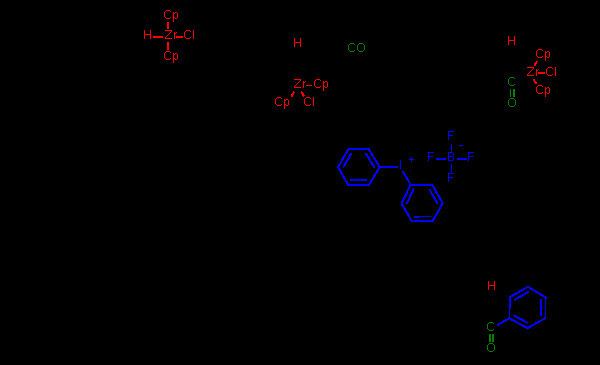 | ||
Organozirconium compounds are organometallic compounds containing a carbon to zirconium chemical bond. Organozirconium chemistry is the corresponding science exploring properties, structure and reactivity of these compounds. In general organozirconium compounds are stable and non-toxic. They are used in organic chemistry as an intermediate in the synthesis of chemical compounds and share characteristics with organotitanium compounds also a Group 4 element. Organozirconium compounds have been widely studied, in part because they are useful catalysts in Ziegler-Natta polymerization.
Contents
The first organozirconium compound discovered (1953) was zirconocene dibromide, belongs to the metallocene family. It was prepared in a reaction of the cyclopentadienyl magnesium bromide and zirconium(IV) chloride. Zirconocenes are used as polymerization catalysts such as Kaminsky catalysts, partly replacing organotitanium compounds.
Hydrozirconation
The so-called Schwartz's reagent (1974) is a zirconocene hydrochloride and a reagent in hydrometalation reactions (called hydrozirconation) with some use in organic synthesis. Substrates for hydrozirconation are alkenes and alkynes. With terminal alkynes the terminal vinyl zirconium product is predominantly formed. Secondary reactions are nucleophilic additions, transmetalations, conjugate additions, coupling reactions, carbonylation and halogenation.
History
The development of zirconium hydrides obviously preceded that of hydrozirconation. The first such hydride, Cp2ZrH2, was developed in 1966 by M.G.H. Wallbridge in a reaction of (Cp)2Zr(BH4)2 with triethylamine in benzene as an uneventful insoluble solid. In 1970 H. Weigold and P.C. Wailes prepared the hydrochloride from the dichloride (Cp2ZrCl2) and Lithium aluminium hydride (or the related LiAlH(t-BuO)3). They went on to investigate the reaction of these novel hydrides with carboxylic acids (for example to compounds like CpZr(OCOR)3) and in 1971 then arrived at their reactions with alkynes.
For example, with one equivalent of Cp2ZrClH they obtained from diphenylacetylene the corresponding alkenylzirconium as a mixture of cis and trans isomer. With two equivalents of hydride the endproduct was a mixture of erythro and threo zircono alkanes:
In 1974 Donald W. Hart and Jeffrey Schwartz realized how these compounds could be used in organic synthesis by reacting the organozirconium intermediates with electrophiles such as hydrochloric acid, bromine and acid chlorides to the corresponding alkane, bromoalkanes and ketones:
The corresponding organoboron and organoaluminum compounds were already known but these are air-sensitive and/or pyrophoric whereas organozirconium compounds are not.
Scope
In one study the usual regioselectivity of an alkyne hydrozirconation is reversed with the addition of zinc chloride:
One example of a one-pot hydrozirconation - carbonylation - coupling is depicted below:
With certain allyl alcohols, the alcohol group is replaced by nucleophilic carbon forming a cyclopropane ring:
Zirconocyclisation
Zirconocene dichloride can be used to cyclise enynes and dienes to give cyclic or bicyclic aliphatic systems.
Organohafnium chemistry
Organohafnium compounds behave nearly identically to organozirconium compounds. Many analogous compounds are known, including bis(cyclopentadienyl)hafnium(IV) dichloride, bis(cyclopentadienyl)hafnium(IV) dihydride, and dimethylbis(cyclopentadienyl)hafnium(IV).
Cationic hafnocene complexes are used as catalysts for polymerization of alkenes. Important post-metallocene catalysts are based on hafnium.
